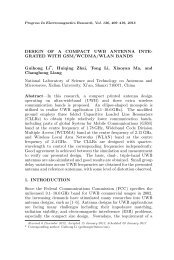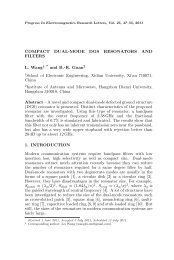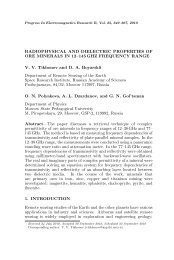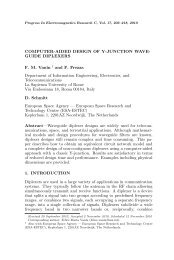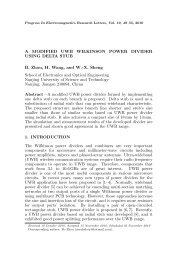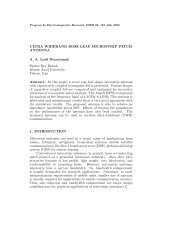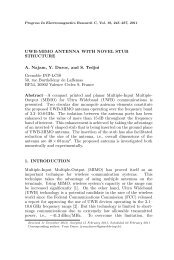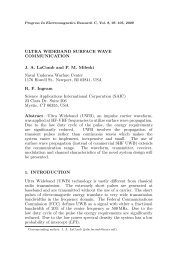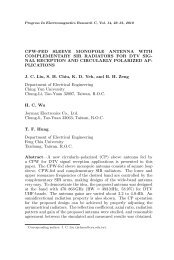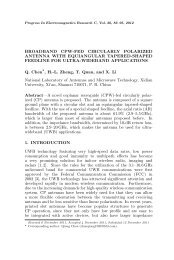ULTRA-WIDEBAND SLOTTED DISC ANTENNA COM ... - PIER
ULTRA-WIDEBAND SLOTTED DISC ANTENNA COM ... - PIER
ULTRA-WIDEBAND SLOTTED DISC ANTENNA COM ... - PIER
You also want an ePaper? Increase the reach of your titles
YUMPU automatically turns print PDFs into web optimized ePapers that Google loves.
Progress In Electromagnetics Research Letters, Vol. 34, 53–63, 2012<br />
<strong>ULTRA</strong>-<strong>WIDEBAND</strong> <strong>SLOTTED</strong> <strong>DISC</strong> <strong>ANTENNA</strong> <strong>COM</strong>-<br />
PATIBLE WITH COGNITIVE RADIO APPLICATIONS<br />
E. Gomez-Nuñez 1 , H. Jardon-Aguilar 1 ,<br />
J. A. Tirado-Mendez 2, * , and R. Flores-Leal 1<br />
1 Telecommunications Section, Research and Advanced Studies Center-<br />
IPN. Av. IPN 2508, San Pedro Zacatenco, Mexico City 07360, Mexico<br />
2 Postgraded Studies and Research Section, ESIME-IPN. Av. IPN S/N,<br />
Door 3. EMC-Lab. Edif. 5. Unidad Adolfo Lopez Mateos, Mexico<br />
City 07300, Mexico<br />
Abstract—In this paper, a new ultra-wideband (UWB) disc antenna<br />
compatible with cognitive radio is presented. The proposed antenna<br />
is developed to operate from 0.77 to 11.23 GHz. It consists of a<br />
circular disc radiator with a rectangular slot on the patch and the<br />
implementation of the bevel technique on the ground plane. A<br />
prototype of the antenna has been constructed and shows adequate<br />
impedance matching, radiation pattern and gain for cognitive radio<br />
applications.<br />
1. INTRODUCTION<br />
Cognitive radio is a communications system that can change its<br />
parameters based on interaction with the environment in which it<br />
operates [1], providing the capability to select and use the best available<br />
channel or share the spectrum in an opportunistic manner.<br />
One of the most novel features of the transceiver for a cognitive<br />
radio system is the ability of sensing and using various bands of interest<br />
which requires specific hardware technologies such as antennas, which<br />
can work efficiently in different bands.<br />
A single antenna is proposed in [2–4] to be employed in cognitive<br />
radio systems that can be tuned or use multiple antennas which are<br />
matched in different bands. However, these options are not the most<br />
appropriate when high integration in small terminals is desired and<br />
working in several bands with fast response, because the reconfigurable<br />
Received 29 May 2012, Accepted 31 July 2012, Scheduled 21 August 2012<br />
* Corresponding author: Jose Alfredo Tirado-Mendez (jatirado@cinvestav.mx).
54 Gomez-Nuñez et al.<br />
antennas need an external tuning circuit and, as shown in [5–7], have<br />
additional power consumption. This takes time to adjust the system<br />
to a desired band. Also, the complexity and number of components<br />
required for the integration into the terminal are increased. The<br />
implementation of multiple antennas raises cost, power consumption,<br />
and increases space for each additional element [8, 9].<br />
Another option is to use a multiband antenna. This alternative<br />
is presented in [10, 11]. However, this type of antennas increases the<br />
complexity of designing and manufacturing when the number of bands<br />
is large.<br />
In this paper, to overcome many of the disadvantages explained<br />
above, the proposed antenna is an UWB antenna, which radiator is<br />
based on a circular patch, since it is easier to design and manufacture<br />
due to the simplicity of the geometry. However, to achieve matching<br />
all over the frequencies of interest, the antenna geometry is modified<br />
in order to obtain the required impedance.<br />
Although, most of the UWB antennas for communication systems<br />
are designed to operate from 3.1 to 10.6 GHz, since this is the<br />
band the Federal Communications Commission has established for<br />
ultra-wideband systems. The proposed antenna works from 0.77 to<br />
11.23 GHz, so a cognitive radio can use several bands as do: GSM 800,<br />
GSM 900, GSM 1800, GSM 1900, WLAN-2.4, WLAN-5.2, or another<br />
standard that works in this range.<br />
The proposed UWB antenna is based on a disc monopole,<br />
because this is the radiator shape that is the most commonly used to<br />
develop monopole antennas for UWB communications systems. Some<br />
results of operating as monopole, the antenna has a wide bandwidth,<br />
omnidirectional pattern, linear polarization and are simple structures<br />
easy to manufacture [12].<br />
One of the most important parameters in a disc monopole is the<br />
radius of the disc, because it determines the lower cutoff frequency.<br />
In [13] the numerical analysis is presented in order to obtain the lower<br />
edge from the radio of the disc.<br />
In the proposed UWB antenna, the disc monopole radiator has<br />
been modified, as well as the ground plane in order to obtain the<br />
desired features, as will be shown in the next sections.<br />
2. <strong>ANTENNA</strong> DESIGN<br />
The monopole is depicted in Fig. 1. As mentioned above, the geometry<br />
of the proposed UWB antenna is based on a disc monopole antenna,<br />
which was designed according to [13], for a lower cutoff frequency of<br />
0.62 GHz, where an antenna of size W = 120 mm by L = 150 mm
Progress In Electromagnetics Research Letters, Vol. 34, 2012 55<br />
Figure 1. Geometry of the new UWB disc antenna.<br />
is obtained, with a disc of radius R = 50 mm, a microstrip feeding<br />
of dimensions Wf = 3.4 mm by Lf = 46 mm, and a ground plane of<br />
size Wg = 120 mm by Lg = 46 mm. However, the present antenna<br />
is mismatched at lower frequencies which are of interest in cognitive<br />
radio applications. To overcome this disadvantage, a rectangular slot<br />
of size Lc = 103.4 mm by Wc = 2.6 mm is introduced, crossing all<br />
the circular disc, and smoothing the edges that connect the outer side<br />
of the radiator with the rectangular slot, forming a circle of radius<br />
Rc = 19 mm. This technique was introduced in order to modify<br />
the current flow on the patch without abrupt changes, obtaining an<br />
improvement in the impedance matching at lower frequencies. The<br />
radiator remains physically connected to the feeding line by two thin<br />
lines of dimensions: 1.029 mm long by 0.4 mm wide.<br />
In order to enhance the impedance matching at higher frequencies,<br />
so as to get the maximum bandwidth and cover the band designated<br />
by the FCC for UWB systems, the bevel technique is implemented on<br />
the ground plane. This approach improves the impedance matching<br />
at lower or higher frequencies depending on the shape of the defect.<br />
However, it also can impact the impedance matching in other bands.<br />
Therefore, after a parametric process employing CST Microwave<br />
Studio software [14], the optimal size to get this goal without affecting<br />
the rest of the bandwidth of interest are Wb1 = 3 mm, Wb2 = 3.2 mm,<br />
Lb = 26.3 mm.<br />
To compare simulation and experimental results, the monopole<br />
was fabricated on a RF35A substrate of thickness 1.524 mm, with a
56 Gomez-Nuñez et al.<br />
(a) (b)<br />
Figure 2. Fabricated prototype of the proposed UWB antenna.<br />
(a) Front view. (b) Back view.<br />
relative permittivity of 3.5. The dimensions of the rectangular slot,<br />
radius of smoothed edges, and the defect on the ground plane, are<br />
the results of an optimization of the antenna achieved by computer<br />
simulation, in order to find the best performance for cognitive radio<br />
applications.<br />
The simulation procedure is done by using the CST software,<br />
which employs the finite integration technique for electromagnetic<br />
computation [14]. To obtain more actual results, in the simulation<br />
process, an SMA connector was introduced as the feeding port the<br />
antenna.<br />
The prototype of the antenna is shown in Fig. 2.<br />
3. SIMULATION AND EXPERIMENTAL RESULTS<br />
The measured and simulated port couplings of the proposed UWB<br />
antenna are presented in Fig. 3. In the simulation, the proposed<br />
antenna has a bandwidth from 0.77 to 11.23 GHz. However, the<br />
measurement results shows the antenna operating from 0.78 to<br />
10.43 GHz, although the antenna does not achieve the bandwidth<br />
obtained by simulations, this continues to be an excellent device<br />
for cognitive radio applications because it has a good impedance<br />
matching for all the bands of interest. The disagreement in the<br />
simulation and measurements is mainly due to the quality of the<br />
SMA connector employed in the construction, which is guaranteed till<br />
10 GHz, approximately, according to the manufacturer. After that<br />
frequency, the impedance of the connector is not well established.
Progress In Electromagnetics Research Letters, Vol. 34, 2012 57<br />
Figure 3. Measured and simulated port matchings of the proposed<br />
antenna.<br />
Figure 4. Comparison of measured port matchings of conventional<br />
and proposed antennas.<br />
Currently, the cognitive radio system is not standardized [15];<br />
the idea is to include the largest possible number of frequency<br />
bands. With these results, it is observed that the proposed prototype<br />
improves the bandwidth offered by other UWB antennas designed<br />
for Cognitive Radio such as [16–20], allowing to include a greater<br />
number of bands in the system. This antenna can be well employed in<br />
many communications systems, including cognitive radio applications.<br />
Moreover, due to the omnidirectional pattern, which is a characteristic<br />
in monopole antennas, the proposed prototype can also be employed<br />
as an electromagnetic spectrum sensor, giving the advantage of using<br />
just one antenna, instead of several devices for different frequencies.
58 Gomez-Nuñez et al.<br />
To show another advantage of the proposed antenna, a comparison<br />
of the measured port matching to a conventional disc monopole with<br />
the same dimensions is made. The conventional monopole radius is<br />
50 mm, and the feeding line is 46 mm long by 3.4 mm wide. Results<br />
are observed in Fig. 4, where a best performance is seen for the antenna<br />
developed in this work.<br />
As observed in Fig. 4, the frequency behavior of the proposed<br />
antenna is better than that got by the conventional disc monopole.<br />
At lower frequencies, the conventional disc monopole is mismatched,<br />
and it is coupled from 4.5 to 10 GHz, approximately. Even more, there<br />
is also a mismatching at 8 GHz. As a result of employing the slots<br />
on the radiator and on the ground plane, the antenna proposed in<br />
this work achieves a wider bandwidth. It is worth it to note that<br />
in the proposed antenna, the slot in the ground plane is etched to<br />
(a) (b)<br />
(c) (d)<br />
Figure 5. Current distribution at (a) 1.8 GHz, (b) 2.4 GHz,<br />
(c) 5.2 GHz and (d) 10 GHz.
Progress In Electromagnetics Research Letters, Vol. 34, 2012 59<br />
overcome the mismatching at higher frequencies generated by the slot<br />
on the radiator. This means, there must be a trade-off between<br />
the dimensions, and geometry of both slots in order to get the best<br />
performance and the wider possible bandwidth of the device.<br />
Figure 5 shows the current distribution on the radiator at different<br />
frequencies. The analysis was set to 1.8, 2.4, 5.2 and 10 GHz.<br />
From this figure, it is seen that the current distribution keeps<br />
stable at different frequencies, keeping the biggest level on the edges of<br />
the radiator, and a small intensity at the center of the patch. In this<br />
kind of UWB antennas, the current distribution is arc-like and flows<br />
along the edge of the antenna as explained before [16]. The changes<br />
in the current distribution make changes in the radiation pattern,<br />
especially at higher frequencies. Then, the slots, etched in the radiator<br />
and the ground plane, are intended to reduce the effects in order to<br />
match the antenna and make the radiation pattern more stable.<br />
The radiation patterns of the prototype have been simulated
60 Gomez-Nuñez et al.<br />
Figure 6. The radiation patterns simulated and measured.
Progress In Electromagnetics Research Letters, Vol. 34, 2012 61<br />
Figure 7. Maximum gain values on the x-z plane.<br />
and measured at 900 MHz, 1.8 GHz, 2.4 GHz, 5.2 GHz and 10 GHz,<br />
and are depicted in Fig. 6. In these figures, at the XZ plane,<br />
quasi-omnidirectional patterns are obtained, so the prototype has an<br />
excellent performance compared to other planar antennas [17–21],<br />
which generally are not omnidirectional in all the bands.<br />
In Fig. 7 the maximum gain values taken every 200 MHz on the<br />
XZ plane are depicted, where there is a good performance of the<br />
antenna in the bands of interest, achieving the possibility to transmit<br />
with less power compared to other antennas [18, 20]. The peak average<br />
gain of the antenna over the bandwidth is around 4.3 dBi.<br />
4. CONCLUSIONS<br />
A new UWB disc antenna compatible with cognitive radio applications<br />
is presented. The antenna is simple to manufacture and requires no<br />
adjustments or extra circuits to operate. It is based on a disc monopole<br />
radiator that has been modified with a rectangular slot on the patch<br />
with smoothed edges, and the implementation of the bevel technique<br />
on the ground plane, in order to improve the coupling in lower and<br />
higher frequencies, respectively, getting a quasi-omnidirectional UWB<br />
antenna which operates from 0.77 to 10.5 GHz.<br />
The proposed antenna design was fabricated, and the measurements<br />
show that there is a good impedance matching for all the bands<br />
of interest and a nearly omnidirectional radiation pattern all over the<br />
bandwidth, improving the results presented by other antennas designed<br />
for the same application.<br />
From the above results, it may be concluded that the proposed<br />
prototype has a performance suitable for cognitive radio applications.
62 Gomez-Nuñez et al.<br />
ACKNOWLEDGMENT<br />
This work was supported by project CONACyT 127856.<br />
REFERENCES<br />
1. Akyildiz, I. F., W. Y. Lee, M. C. Vuran, and S. Mohanty, “NeXt<br />
generation/dynamic spectrum access/cognitive radio wireless<br />
networks: A survey,” Comp. Networks J., Vol. 50, 2127–2159.<br />
Sep. 2006.<br />
2. Mitola, J., Introduction in Cognitive Radio Architecture: The<br />
Engineering Foundations of Radio XML, John Wiley & Sons, Inc.,<br />
Hoboken, NJ, USA, 2005.<br />
3. Arslan, H., Cognitive Radio, Software Defined Radio, and<br />
Adaptive Wireless Systems, Springer, The Netherland, 2007.<br />
4. Fett, B. A., Cognitive Radio Technology, 2nd Edition, Elsevier,<br />
USA, 2009.<br />
5. Oh, S.-H., H. Song, J. T. Aberle, B. Bakkaloglu, and<br />
C. Chakrabarti, “Automatic antenna-tuning unit for softwaredefined<br />
and cognitive radio,” Wireless Communications & Mobile<br />
Computing, Vol. 7, No. 9, 85–88, Nov. 2007.<br />
6. Abu Tarboush, H. F., S. Khan, R. Nilavalan, H. S. Al-Raweshidy,<br />
and D. Budimir, “Reconfigurable wideband patch antenna for<br />
cognitive radio,” 2009 Loughborough Antennas and Propagation<br />
Conference, 141–144, Nov. 2009.<br />
7. Hall, P. S., P. Gardner, J. Kelly, E. Ebrahimi, M. R. Hamid,<br />
F. Ghanem, F. J. Herraiz-Martinez, and D. Segovia-Vargas,<br />
“Reconfigurable antenna challenges for future radio systems,”<br />
2009 Berlin EuCAP Antennas and Propagation Conference, 949–<br />
955, Jun. 2009.<br />
8. Neihart, N. M., S. Roy, and D. J. Allstot, “A parallel,<br />
multi-resolution sensing technique for multiple antenna cognitive<br />
radios,” ISCAS 2007 IEEE International Symposium on Circuits<br />
and Systems, 2530–2533, May 2007.<br />
9. Zhang, R. and Y.-C. Liang, “Exploiting multi-antennas for<br />
opportunistic spectrum sharing in cognitive radio networks,”<br />
IEEE Journal of Selected Topics in Signal Processing, Vol. 2,<br />
No. 1, 88–102, Feb. 2008.<br />
10. Wu, T., R. L. Li, S. Y. Eom, K. Lim, S. I. Jeon, J. Laskar, and<br />
M. M. Tentzeris, “A multiband/scalable reconfigurable antenna<br />
for cognitive radio base stations,” 2008 IEEE Antennas and<br />
Propagation Society International Symposium, 1–4, Jul. 2008.
Progress In Electromagnetics Research Letters, Vol. 34, 2012 63<br />
11. Harada, H., “A software defined cognitive radio prototype,” IEEE<br />
PIMRC 2007 18th International Symposium on Personal, Indoor<br />
and Mobile Radio Communications, 1–5, Sep. 2007.<br />
12. Liang, J., C. C. Chiau, X. Chen, and C. G. Parini, “Study of a<br />
printed circular disc monopole antenna for UWB systems,” IEEE<br />
Transactions on Antennas and Propagation, Vol. 53, No. 11, 3500–<br />
3504, Nov. 2005.<br />
13. Sim, C.-Y.-D., W.-T Chung, and C.-H. Lee, “A circular-disc<br />
monopole antenna with band-rejection function for ultrawideband<br />
application,” Microwave and Optical Technology Letters, Vol. 51,<br />
No. 6, 1607–1613, Jun. 2009.<br />
14. Computer Simulation Technology (CST) Microwave Studio,<br />
Electromagnetic Field Simulation software, Darmstadt, Germany,<br />
www.cst.com.<br />
15. Grayver, E., “Standardization efforts for software-defined radio,”<br />
2010 IEEE Aerospace Conference, 1–8, Mar. 2010.<br />
16. Cai, Y., H. Cui, and Z. Feng, “The research of the frequency<br />
dependency of UWB antenna radiation pattern,” Proceeding of<br />
2010 IEEE International Conference on Ultra-wideband, 1–4,<br />
2010.<br />
17. Kelly, J. R., E. Ebrahimi, P. S. Hall, P. Gardner, and F. Ghanem,<br />
“Combined wideband and narrowband antennas for cognitive<br />
radio applications,” 2008 IET Seminar on Cognitive Radio and<br />
Software Defined Radios: Technologies and Techniques, 1–4,<br />
Sep. 2008.<br />
18. Ghanem, F., P. S. Hall, and J. R. Kelly, “Two port frequency<br />
reconfigurable antenna for cognitive radios,” Electronics Letters,<br />
Vol. 45, No. 11, 534–536, May 2009.<br />
19. Ebrahimi, E. and P. S. Hall, “A dual port wide-narrowband<br />
antenna for cognitive radio,” EuCAP 2009 3rd European<br />
Conference on Antennas and Propagation, 809–812, Mar. 2009.<br />
20. Rao, P. H., “Antenna configurations for software defined radio<br />
and cognitive radio communication architecture,” ICWCSC 2010.<br />
International Conference on Wireless Communication and Sensor<br />
Computing, 1–4, Jan. 2010.<br />
21. Ebrahimi, E. and P. S. Hall, “Integrated wide-narrow band<br />
antenna for multiband applications,” Microwave and Optical<br />
Technology Letters, Vol. 52, No. 2, 425–430, Feb. 2010.





